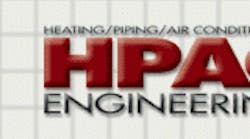Underfloor-Air-Distribution Design Concepts
By Jenny Abney
UFAD systems save energy and deliver better occupant comfort and indoor-air quality for certain applications...MORE
The Return of Johnny Tundra, Another Engineering Whodunit From the Frozen North
By Ronald Wilkinson, PE
"I have a feeling your cooling problem isn't in your unit ventilator; it's in your machine room!"--Johnny Tundra
Troubleshooting MEP systems in cold climates can be an urgent matter. Fortunately, there are engineers such as Johnny Tundra roving the northern-tier states and tackling the flintiest of facility problems. Join Johnny through his travels in wintertime Montana, and match wits with him as he looks to keep the frozen northland outside, where it belongs...MORE
Free HPAC Engineering Webinar:
Aquatic-Center Success: Form Follows the Function of Water, Air, and Motion
Wednesday, May 14, 2008 @ 2 p.m. ET
Sponsor Desert Aire -- www.desert-aire.com
We have all heard the famous adage, "Form follows function." It is a basic tenet of designing a successful building or facility.
Such is the case for aquatic centers, too. Environmental conditions within these facilities are unlike those found in most large buildings and structures. Major differences that affect the indoor environment include the vast amount of exposed and treated water in pools, the airflow and humidity levels within the facilities, and the rigorous activities that are conducted within them. Understanding how these factors affect your facility and knowing how to design for their impact directly affect the longevity and long-term success of your natatorium.
Join a special Webcast presented by John McIlhargy, director of the Facility Development Department for USA Swimming, along with Harry Milliken III, Northeast regional sales manager for Desert Aire, as they discuss these important issues and provide practical solutions to help you develop and maintain a successful aquatic center. To learn more about our presenters, click here.
This Webinar will cover:
- Chloramines and their negative impact on pool structures.
- Proper chemical composition of pool water.
- The effects and treatment of air stratification above pools.
- Meeting ASHRAE Standard 62 for swimmers and spectators.
- Appropriate facility pressurization, humidity levels, and air distribution.
- Saving energy as you heat pool water.
Unable to attend an HPAC Engineering Webinar? Log on to HPAC Engineering's Website and view an archive of its Webinar series. Webinar topics covered include lower energy costs with rooftop package units, pumping and piping systems for tall buildings, rightsizing rooftop equipment, and new trends in laboratory exhaust...MORE
AIA Releases Study of Three Green-Building Rating Systems
The American Institute of Architects (AIA) has released a study of three green-building rating systems (the Green Building Initiative's Green Globes, the International Initiative for a Sustainable Built Environment's SBTool 07, and the U.S. Green Building Council's Leadership in Energy and Environmental Design [LEED] NC 2.2 system). The study assesses these systems' effectiveness in supporting the goals of the AIA sustainability position statement...MORE
Protecting Building Environments From Airborne CBR Attacks
The report, "Guidance for Protecting Building Environments From Airborne Chemical, Biological, or Radiological Attacks," published by the National Institute for Occupational Safety and Health, focuses on building air-protection issues associated with airborne chemical, biological, or radiological (CBR) attacks. HVAC systems and their components should be evaluated with respect to how they impact vulnerability to the introduction of airborne CBR agents...MORE
The U.S. Green Building Council recently posted improved submittal templates online for Leadership in Energy and Environmental Design (LEED) for Existing Buildings: Operations & Maintenance...MORE
Green-Design by the Numbers
The current global focus on being green 'i.e., saving energy and protecting the environment' has created a craze that is sweeping the country, even down to the consumer level. A lot of critics say those touting global warming are nothing more than Chicken Little-like fanatics or boys crying wolf. Some even cite evidence about global cooling. But whether we are enmeshed in a global-warming cycle or a global-cooling phenomenon does not really matter. The key issue is we need to be smarter about our energy consumption. And those of us in the HVAC industry can make a significant difference by designing greener, more energy-efficient mechanical systems. Consider the following facts and you will understand the impact greener mechanical systems can have...MORE
Design/Build Seminar Set to Return in October
Building on the success of 2007, the 2008 Commercial Contracting Roundtable & Design/Build Seminar is back and better than ever. Mark your calendars and plan to join Contracting Business magazine on Nov. 12 and 13 at Hilton Atlanta Airport Hotel in Atlanta, Ga. This is an important event for design engineers looking to make the most of the opportunities in the commercial HVACR market...MORE









